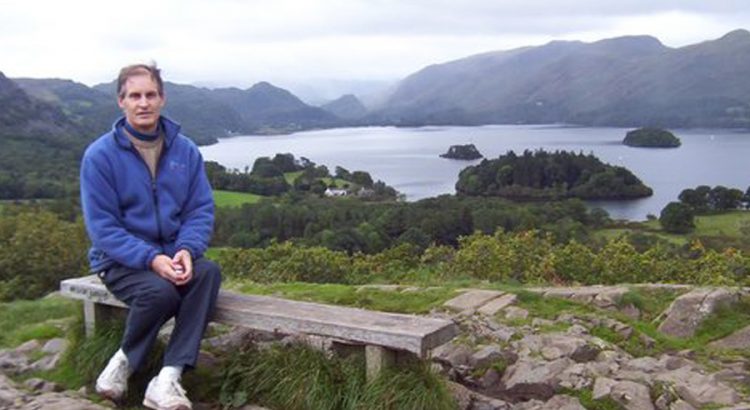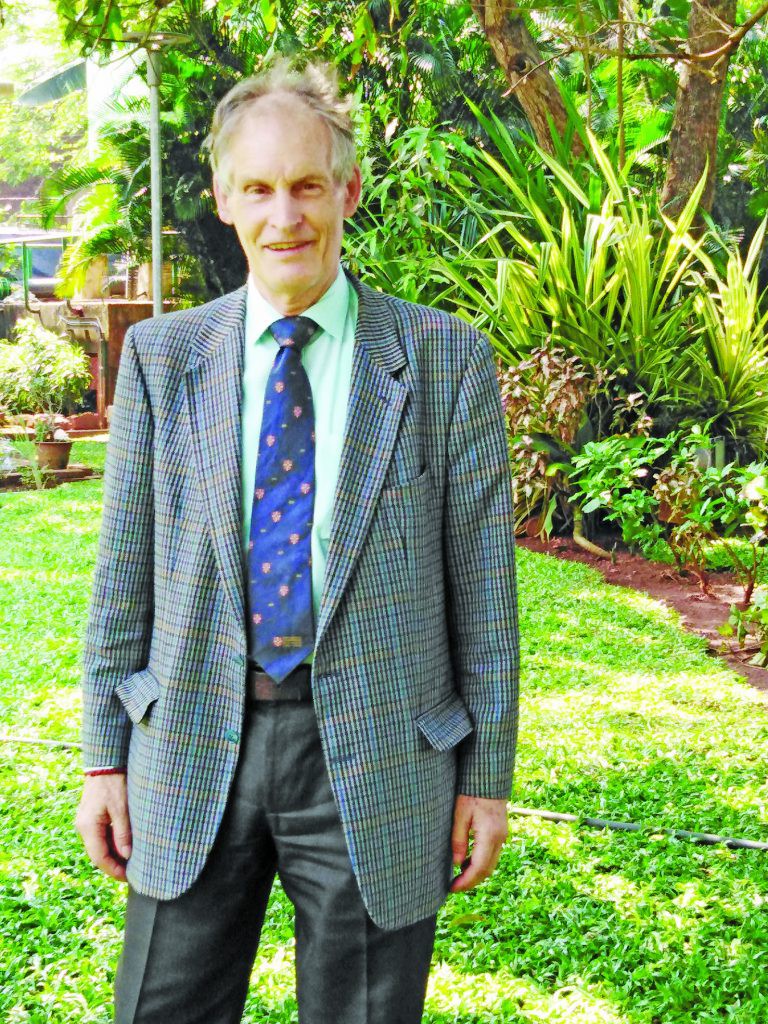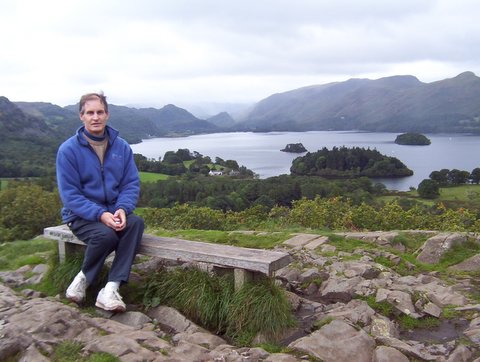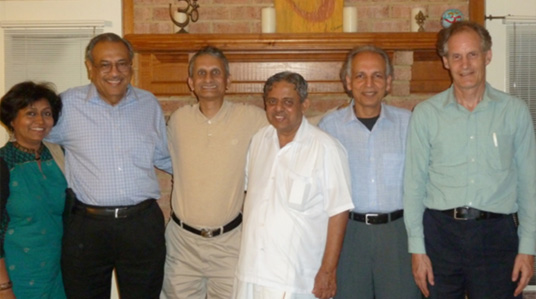Ayurveda can make India the world capital for curing chronic ailments – says MIT-Cambridge Professor
Indian sciences can solve modern medical problems because they recognise the difference between the gross physical level, Sthula, and the more subtle, Sukshma, level(s) – Professor Alex Hankey
Professor Alex Hankey, a British theoretical physicist trained at Massachusetts Institute of Technology and Cambridge University, was first introduced to the power of meditation when as a 10 year old child he lost his mother and found solace in repeating a small prayer, not realising then that it became a mantra for him.
When he went to boarding school, he couldn’t cry himself to sleep as he was in a dormitory with 10 other little boys. “So I told a little prayer, ‘God bless Mummy.’ And I repeated it over and over, I didn’t know at that time, like a mantra. It took me to a level, after a year or so, of blissful silence,” he said speaking to CSP at S-VYASA in Bengaluru.
A year later, his older sister gave him a book – The autobiography of St Theresa of Avila – which described in great detail what it called the seven stages of prayer. “I could see I was somewhere near stage 3 and a half. Therefore I got the understanding that if you progressed on this path of meditation you could arrive at great things,” says Alex.
Meditation helps to tap the mind’s potential. Prof Hankey says, “We like to explain the mind as an ocean, manasa sagara if you like. It has got lots of waves on the surface, driven by information coming in through the five senses. Most people only have an access of 5-10 per cent of that. Even Einstein said he had access to only 15 per cent of his mind. So you have this vast body of mind, mental potential which is largely untapped. So how do you meditate? You do various procedures given in Patanjali to let the mind settle down. Then you have the procedure which turns the mind inwards. Patanjali terms it as Pratyahara. Once the mind is turned inwards it is actually attracted automatically to this area of inner bliss. This level of silence is the level of pure Ananda. So our understanding is that when you are given an inner direction and you have the mantra to take you there, dhyana takes place automatically.”
Prof Hankey says that one does not stay long in this state because the nature of this stage is that it energises the mind which releases stress, and once this happens you come out of this phase. “So the whole process is cyclical. You go inwards with the mantra, letting go and the system gets energised with Shakti. It worked like a dream for me. It got rid of the stress that I had been carrying for years. I didn’t need asprins.”
Deeply interested in Vedanta, Yoga, and Ayurveda, Prof Alex has played a vital role in setting up Maharishi University of Management and later on taught their first undergraduate course in Philosophy of Science. It was while studying at the MIT that he learned of Maharishi Mahesh Yogi’s Transcendental Meditation technique (TM). He appreciated the technique so much that he became a teacher of the technique immediately on graduating from M.I.T., during the year that he spent at Stanford.
Speaking about meditation and its ability to take one to higher states of consciousness, Professor Hankey quotes his colleague at TM who identified three types of meditation. “One is called Focussed Attention (Volunteering of attention on a chosen subject), and that produces a certain kind of brain waves of high frequency 30-40 cycles per second (gama waves in front of the head). Another is called Open Monitoring Technique (nonreactive monitoring of the content of experience from moment to moment) which produces Theta waves all along the midline. Then the third is called Automatic Self-Transcending Systems (transcends the steps of the meditation practice leading to pure consciousness). When you reach the transcendental phase you experience inner silence and bliss and the effect of being in that state completely transforms the pattern of your physiological functioning. Anxiety goes away, depression, much more slowly, is eased. The mind enters a state which is called Alpha. The alpha starts classically at the back of the head and then spreads all over cortex and all the main lobes of the brain are involved. We got these results very very clearly.”
Professor Hankey says that this was an area of great interest in the early 1970s. A French neurophysiologist at TM started researching the deeper aspects of meditation and got very good results. “In 1978, the Frenchman set up a laboratory in the UK and we asked the best researcher in EEG in the UK, John C Shaw to evaluate the research. When we told him we see frontal alpha, he said ‘You see what’.”
The TM team told John Shaw that they saw the alpha waves start at the back of the head and then spread forward and eventually become coherent when people get more experienced at meditation and that they saw it in all the participants.
“Even in early meditators you see this signal which is characteristic of inner peace starting in the back and becoming global on both hemispheres. When I said to him we see alpha frequency waves in the front of the head he said that he had never seen that in his life. He said he wouldn’t call that alpha if he saw it from the front of the head because alpha waves are seen only at the back of the head. So it’s very real, it is completely reliable, we see it completely reliably, and it’s apparently unique. When you ask yourself what is it that is happening you are putting your mind in a state which is fully awake in itself. But there is no informational content, there are no thoughts, there are no emotions, and there may be a feeling of bliss. It is basically what I call a state which is ‘empty’. There is no information content but you are not asleep. Some people say, rather wittily, it is rather like falling awake. It is reliable and for various reasons it is automatic.”
Prof Alex spent 30 years teaching TM and the Vedic Sciences in different countries. He returned to research in 2002, and came to Bangalore in 2007, where he met S-VYASA Vice-Chancellor, Dr HR Nagendra within two months of arriving. He joined the university five months later. His current work at S-VYASA relates to applying a combination of philosophical arguments and knowledge of Vedic sciences to solve problems in modern science, and thereby refining the foundations of physics, biology, and information theory.
Comparing Indian sciences to Western practices, Prof Hankey says that Indian traditional sciences depend on the well-defined process of cognition from the Yogic state of Ritam Bhara Pragya described at the end of Patanjali Yoga Sutras Pada I. “When the applied Vedic sciences such as Ayurveda, Dhanurveda, Gandharva Veda, Sthapatya Veda, Shiksha, Vyakarana, Jyotisha, Nyaya, Samkhya, and Yoga are considered, the feedback of empirical success into the structure of knowledge and teaching are very much in evidence, also in the Arts such as Natya Shastra, Painting or Sculpture, to name but a few.”
Prof Hankey says Indian sciences can solve modern problems because “they recognise the difference between the gross physical level, Sthula, and the more subtle, Sukshma, level(s). The western sciences have almost no idea of the existence of the latter, and tend to deny evidence for it when data indicating their existence is brought up. Great scientists like Rupert Sheldrake in the UK report highly negative treatment at the hands of senior scientists who are convinced that they themselves know best – when they don’t. The power of the Sukshma levels can explain all the great results reported in ancient Indian sciences.” Prof Hankey says he has developed an authentic and powerful theory of how the Sukshma fits into the physical world.
And that theory is rooted in Ayurveda which he says has the ability to assess patients’ pathologies at a Sukshma level. His student Dr Purnima Datey in Bhopal has demonstrated cures for several chronic diseases using methods of the AYUSH systems of medicine. “Her system of Rasahara can make India a world capital for curing Chronic Kidney Disease (CKD). Our work shows that failing to follow any principle of Ayurveda Ahara-Vihara constitutes a risk factor for a corresponding pathology – also that Yoga practice systematically reduces complications of several pathologies.”
Prof Hankey says that coming from a family of great Vaidyas, Dr Poornima grew up with Ayurveda in her “blood and bones”. Describing her ability as being intuitive, he credits her with his greatest discovery in Ayurveda and Yoga. For instance, the basis of most scientific research done on diabetic drugs is to observe how much of a shift is produced in bio-chemical markers during post-prandial or fasting blood sugar. Ayurveda allows one to have a very different strategy on how drug intervention works.
Dr Poornima found that Ayurveda normalises the variants, bringing them back to their normal range. “For example if you give one of these drugs to someone with normal blood sugar it doesn’t change. But if you give it someone who is diabetic, it will reduce their blood sugar.”
While mainstream research would take an experimental group of 50 people with different values of blood sugar, and compress the whole distribution to study shifts from the mean, the Ayurvedic approach of Dr Poornima and Alex insists it is more important not to look at the shift in mean and instead look at the “shift in distribution of variants or standard deviation. If you look at the width of the distribution you find that you get extraordinary results, much more significant than if you say, how much the shift from the mean it is. This is entirely due to her research. We were able to frame her qualitative research into quantitative terms. We have verified this for yoga interventions in many different studies.”
Alex says that Vedic Yajnas and Yagas also act at a subtle level and can achieve goals that would otherwise be unattainable. “From the simplest like Agni Hotra or Graha Shanti, which can greatly protect the individual and solve personal problems, through Yagyas like Parjanya Yagya that can bring rain to drought stricken areas, and on to the Vedic Civilisation’s great performances such as the Maha Soma Yagas, which can create harmony and peace throughout a nation, and the Rudra Abhishek’s which can create a Kavach for an entire nation (Ati-Rudra Abhishek) or resolve major world crises, such as its performance in 1944 by the Shankaracharya of Jyotir Math in order to bring World War II to a timely conclusion.”
MAKING INDIC KNOWLEDGE SYSTEMS MAINSTREAM
Indic knowledge systems including Indic technology, Vedic Physics, Ayurveda, Yoga can become mainstream, says Prof Hankey, by establishing well-respected empirical validation of scientific conjectures derived from them.
“Yoga has been thoroughly validated, and the numbers of Randomized Controlled Trials conducted at such prestigious institutions as Harvard University, M.D. Anderson in Houston, Texas, and NIMHANS in Bengaluru (not to speak of S-VYASA) is steadily increasing. Similarly the number of case studies and randomized controlled trials of Ayurveda is steadily increasing. There is now a national move in India to promote AYUSH integrative medicine More work on foundations of Yoga is needed; particularly its ability to produce higher states of consciousness like those intimated in the second half of Mandukhyopanishad (vs. 6 to end) verifying the principles enunciated in Ishopanishad, Yoga Sutras etc. Decisive work has been carried out on the Sukshma Sharira, verifying such statements as Padmasana being the most effective means to energize the subtle body (its verification led to one of my Phd students being named Valedictorian of his graduating class).”
In the field of Ayurveda, Prof Hankey says South Indian cuisine with its Sambhar and Rasam emphasises replacement of mineral losses due to Swedana. “Both systems use the fundamental masalas including Haridra, Ginger, Dhanya and Black Pepper, that reduce cancer, especially in the GIT (Haridra), enhance digestion (Ginger and Dhanya) and absorption (Black Pepper). The popularisation of various Indian curry dishes, and modes of cooking such as Tandoori, around the world, does much to enhance awareness around the world of India’s culture, both historic and contemporary.”
Prof Hankey frequently catches up with his colleague from Cambridge and MIT, Nobel laureate Brian David Josephson, also a physicist and they offer each other advice and opinions on their respective programs of research and sometimes attempt collaboration. Prof Hankey’s work is well known with other members of Trinity College, and his research results in Ayurveda and Yoga has been acknowledged by Master of the College, Sir Greg Winter, the recent recipient of the last Nobel Prize in Physiology and Medicine
09/06/2013 – Alex Hankey “Decoding Ayurveda: Can Vedic Insights Lead to Breakthroughs in..”
 English
English  Magyar
Magyar







